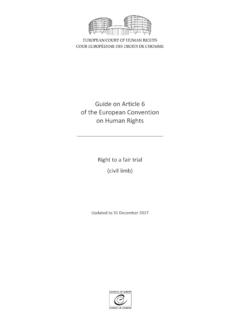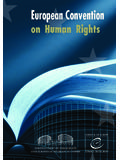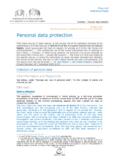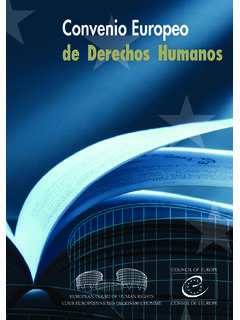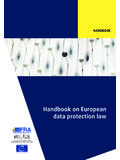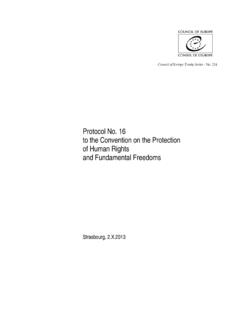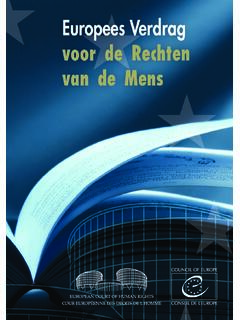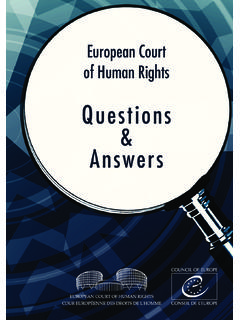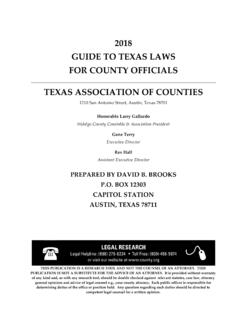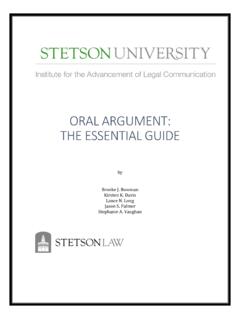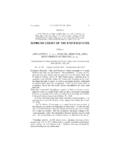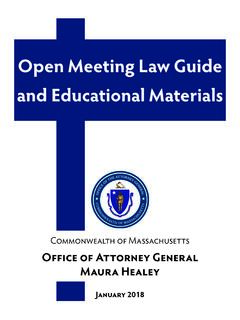Transcription of The ECHR in 50 questions
1 EUROPEAN COURT OF HUMAN RIGHTSCOUR EUROP ENNE DES DROITS DE L'HOMMETHE ECHRIN 50 QUESTIONSE uropeanCourtof HumanRightsENG?The ECHRin 50 questions 3 FAQE uropean Court of Human Rights: The ECHR in 50 questionsThe European Convention on Human Rights1 When was the Convention adopted?The Convention for the Protection of Human Rights and Fundamental Freedoms, better known as the European Convention on Human Rights , was opened for signature in Rome on 4 November 1950; it entered into force on 3 September Convention gave effect to certain of the rights stated in the Universal Declaration of Human Rights and established an international judicial organ with jurisdiction to find against States that do not fulfil their is a protocol to the Convention?A protocol to the Convention is a text which adds one or more rights to the original Convention or amends certain of its which add rights to the Convention are binding only on those States that have signed and ratified them; a State that has merely signed a protocol without ratifying it will not be bound by its date, 16 additional protocols have been adopted.
2 3 Which rights are protected by the Convention?States that have ratified the Convention, also known as States Parties , have undertaken to secure and guarantee to everyone within their jurisdiction, not only their nationals, the fundamental civil and political rights defined in the rights and freedoms secured by the Convention include the right to life, the right to a fair hearing, the right to respect for private and family life, freedom of expression, freedom of thought, conscience and religion and the protection of property. The Convention prohibits, in particular, torture and inhuman or degrading treatment or punishment, forced labour, arbitrary and unlawful detention, and discrimination in the enjoyment of the rights and freedoms secured by the the Convention evolve?Yes. The Convention evolves especially by means of the interpretation of its provisions by the European Court of Human Rights.
3 Through its case-law the Court has made the Convention a living instrument; it has thus extended the rights afforded and has applied them to situations that were not foreseeable when the Convention was first Convention has also evolved as and when protocols have added new rights: for example in July 2003, with Protocol No. 13 concerning the abolition of the death penalty in all circumstances, or in April 2005, with Protocol No. 12 on domestic courts obliged to apply the Convention?The Convention is applicable at national level. It has been incorporated into the legislation of the States Parties, which have undertaken to protect the rights defined in the Convention. Domestic courts therefore have to apply the Convention. Otherwise, the European Court of Human Rights This document has been prepared by the Public Relations Unit of the Court and does not bind the Court.
4 It is intended to provide basic general information about the way the Court works. For more detailed information, please refer to documents issued by the Registry available on the Court s website European Court of Human Rights, 2021 European Court of Human Rights Council of Europe 67075 Strasbourg cedex France 5 FAQFAQE uropean Court of Human Rights: The ECHR in 50 questionsEuropean Court of Human Rights: The ECHR in 50 questions 4would find against the State in the event of complaints by individuals about failure to protect their European Court of Human Rights (ECHR)6 What is the Court s composition?The number of judges on the Court is the same as that of the States Parties to the are the Court s judges elected?The judges are elected by the Parliamentary Assembly of the Council of Europe from lists of three candidates proposed by each State. They are elected for a non-renewable term of nine the judges really independent?
5 Although judges are elected in respect of a State, they hear cases as individuals and do not represent that State. They are totally independent and cannot engage in any activity that would be incompatible with their duty of independence and judges sit in cases concerning their own country? National judges cannot sit in a single-judge formation. In exceptional cases, they may be invited to sit in a Committee. However, the composition of the Court always includes the national judge when it hears cases as a seven-judge Chamber or a seventeen-judge Grand is the Registry and how is it run?The Registry is the body of staff that provides the Court with legal and administrative support in its judicial work. It is made up of lawyers, administrative and technical staff and is the Court s budget?The Court s expenditure is borne by the Council of Europe, whose budget is financed by contributions from member States in accordance with scales based on population and budget covers the salaries of judges and staff and the various overheads (IT, official travel, translation, interpreting, publications, representational expenses, legal aid, fact-finding missions, etc.)
6 12 Can the Court s composition vary from one case to another?Yes, cases are heard by one of four main inadmissible applications are examined by a single judge. A three-judge Committee may rule by a unanimous vote on the admissibility and merits of cases that are already covered by well-established case-law of the Court. An application may also be assigned to a seven-judge Chamber which rules by a majority vote, mostly on the admissibility and merits of a , the Grand Chamber of 17 judges hears cases referred to it either after relinquishment of jurisdiction by a Chamber or when a request for referral has been is the difference between a Chamber and a Section?A Section is an administrative entity and a Chamber is a judicial formation of the Court within a given Court has five Sections in which Chambers are formed. Each Section has a President, a Vice-President and a number of other are Chambers and Grand Chambers formed?
7 A Chamber is composed of the President of the Section to which the case was assigned, the national judge (the judge elected in respect of the State against which the application was lodged) and five other judges designated by the Section President in Grand Chamber is made up of the Court s President and Vice-Presidents, the Section Presidents and the national judge, together with other judges selected by drawing of lots. When it hears a case on referral, it does not include any judges who previously sat in the Chamber which first examined the does the Grand Chamber hear a case?The initiation of proceedings before the Grand Chamber takes two different forms: referral and a Chamber judgment has been delivered, the parties may request referral of the case to the Grand Chamber and such requests are accepted on an exceptional basis.
8 A panel of judges of the Grand Chamber decides whether or not the case should be referred to the Grand Chamber for fresh are also sent to the Grand Chamber when relinquished by a Chamber, although this is also exceptional. The Chamber to which a case is assigned can relinquish it to the Grand Chamber if the case raises a serious question affecting the interpretation of the Convention or if there is a risk of inconsistency with a previous judgment of the a judge refuse to sit in a case?Yes. Judges are in fact obliged to refrain from taking part in the consideration of a case when they have previously acted in that case in any capacity. This is called withdrawal. They are replaced in the proceedings by another judge and an ad hoc judge is appointed if it is the national judge who is an ad hoc judge?An ad hoc judge is appointed by the government concerned when the national judge does not sit in the case because of inability, withdrawal or is the scope of the Court s jurisdiction?
9 The Court cannot take up cases of its own motion. It has jurisdiction to hear allegations of violations of the European Convention on Human Rights and does so on receiving individual or inter-State applications. 7 FAQFAQE uropean Court of Human Rights: The ECHR in 50 questionsEuropean Court of Human Rights: The ECHR in 50 questions 6 Proceedings before the Court19 Who can bring a case to the Court?The Convention makes a distinction between two types of application: individual applications lodged by any person, group of individuals, company or NGO having a complaint about a violation of their rights, and inter-State applications brought by one State against the Court was established, almost all applications have been lodged by individuals who have brought their cases directly to the Court alleging one or more violations of the are cases brought against?Cases can only be brought against one or more States that have ratified the Convention.
10 Any applications against third States or individuals, for example, will be declared are cases brought before the Court?Cases can be brought directly by individuals and the assistance of a lawyer is not necessary at the start of the proceedings. It is sufficient to send the Court a duly completed application form with the requisite documents. However, the registration of an application by the Court is no guarantee that it will be admissible or successful on the Convention system provides for easy access to the Court, enabling any individual to bring a case even if he or she lives in a remote region of a member State or is penniless. With this in mind, there are no fees for proceedings before the is the difference between an individual application and an inter-State application?Most applications before the Court are individual applications lodged by private persons.
